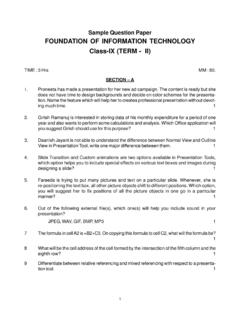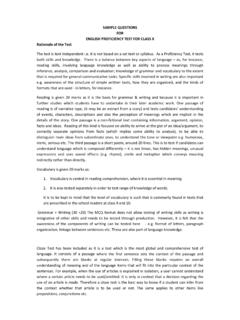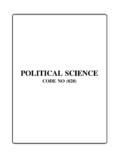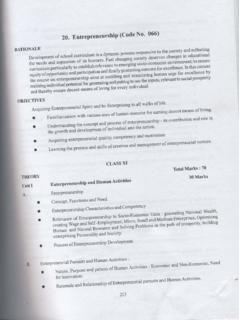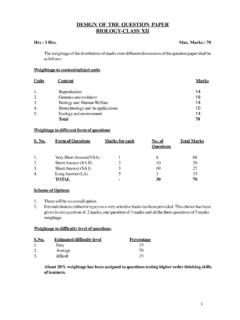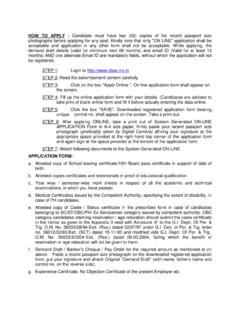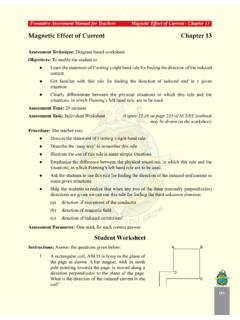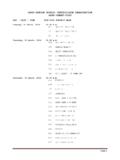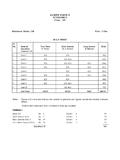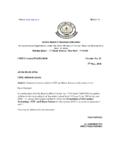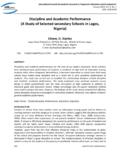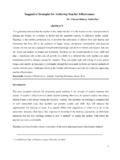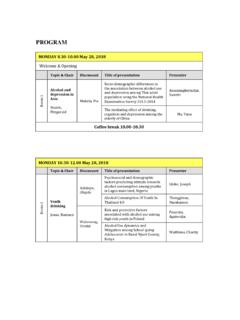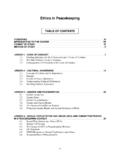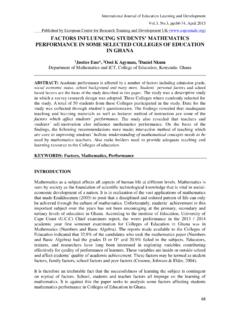Transcription of For Student Activities - CBSE
1 For Student ActivitiesTeachers WorkbookAdolescence Education ProgrammeivContentsList of AbbreviationsxiiSection IIntroduction2 Section IIA Classroom Guide for Conducting Adolescence Education Programme10 SessionTopicModalityDurationPageClassroo m Session 1 :Healthy Growing Up, Adolescent Health Issues (AHI)Topic 1: Growing up and Changes during Adolescence21 Activity 1: Understanding Adolescence and the Growing-Up Process Brainstorming and Group Discussion 60 2: Perspective building on Life Skills Development25 Activity 1: Understanding Development of Life-SkillsStory Analysis, Brain-Storming and Group Discussion60 2: Developing Emotional Sensitivity (Empathy) 20 3: Thinking Critically and Going Beyond the Surface70 4: If the Earth had Two Moons30 5: Let s learn to apply Life-Skills!
2 Brain-Storming and Group Discussion60 6: Appreciating oneselfGroup Activity and Discussion30 7: I want to feel good about myselfSmall Group Activity and Discussion30 8: Analysing Strength, Weaknesses, Opportunities, Threats (SWOT) 30 9: My Value System30 10 : But This Not Fair (Being Responsible)20 11: Self Awareness40 Workbookfor Student ActivitiesvContentsTopic 3: Understanding Adolescent Health Issues (AHI)50 Activity 1: Menstrual HygieneGroup Guided Discussion, Case Study Analysis 30 2: Analysis Advertisements Media for Developing Good Nutrition Practices30 3: Healthy Growing Up30 4: Lets Celebrate Abstinence30 5: Rights and Responsiblities30 6: Understanding Relationship and Building Positive Traits30 7: Expectation from PeopleIndividual20 8: The Person I AdmireIndividual20 9: Positive Strokes- Creating a Zone of Happiness30 4: Developing Gender Sensitivity 65 Activity 1: Different Roles Different ExpectationsBrainstorming and Group-Discussion45 2: Understanding gender Question and answer session45 3: Lets Clarify Whose Job Is It 4: Analysing Short Stories For Gender Stereotypes30 : Gender Discrimination30 6.
3 Sexual Abuse - Awareness Building and Sensitising20 Education ProgrammeviContentsSessionTopicModalityD urationPageActivity 7: Sexual Abuse - What Can I Do?20 of Classroom Session 1 and Questions in the Question BoxQuestion Box30 Session 2 :RTIs/STIs and HIV/AIDST opic 5: Reproductive Tract Infections and Sexually Transmitted Infections: Basic Facts83 Activity 1: Let s Discuss Young People and STIsPresentation and Quiz45 6: HIV/AIDS: Basic Facts, Transmission and Prevention86 Activity 1: Let s Discuss HIV/AIDSQuiz, Group Discussion and Presentation 75 2: Assessing the Risk of HIV/AIDS TransmissionQuestion and Answers 45 3: Crossing the Road20 4: What if ?
4 20 5: Who Discriminates?20 6: Social Issues of HIV30 7: Living Positively100 Activity 1: I want to be CompassionateCase-Study Analysis, Group -Discussion60 2: I am HIV+ A Role-Play Role-Play, Group -Discussion60 3: Attitudes AIDS Creating Empathy20 8: Personal Beliefs and Opinions107 Activity 1: Clarifying Beliefs Group-Game and Discussion45 2: Me and my Parents`.. Celebrating our Communication45 3: Learning to Deal with Anger45 Workbookfor Student ActivitiesviiTopic 9: Enhancing Decision Making Skills117 Activity 1: Make a BidGroup Game60 2: Let s do Making DecisionsSituation Analysis and Group Discussion60 3: Johari Window40 4: Crossing The Road20 5: What if?
5 20 6: Who Discriminates?20 7: Social Issues of HIV/AIDS30 of Classroom Session 2 and Questions in the Question BoxQuestion Box30 Session 3 :Preventing Substance AbuseTopic 10: Substance Abuse: Basic Facts131 Activity 1: Know the Facts Brainstorming, Group Discussion, Case-Study Analysis, Presentation60 2: Influence of Advertising on Drinking and Smoking30 11: Understanding and Coping with Peer Pressure141 Activity 1: Let s know - Peer-Pressure Situation Analysis and Group- Discussion 60 2: Peers: Do They Count? Situation Analysis and Group - Discussion60 3: Expressing What You MeanRole-Play and Group-Discussion60 4: How Can I Be Assertive?
6 30 5: Resisting Peer PressureRole Play and Group Discussion60 6: Practicising Abstinence - How to Say No?30 Education ProgrammeviiiTopic 12: Guided Meditation and Creative Visualisation160 Topic 13: Coping with Emotions and Stress167 Activity 1: Dealing with PressuresGroup-Game, Brain-Storming and Group- Discussion30 2: Coping With StressGroup-Discussion30 3: Empty Chair- Dealing with Emotion30 4: Colours of LifeGroup-Discussion30 5: The Road Map - Planning and Goal Setting30 6: Time Management30 of Classroom Session 3 and Questions in the Question BoxQuestion Box30 1: Contents of the AEP Training Package180 Annexure 2.
7 Suggested format for Record Keeping of Activities done under AEP Programme by the Nodal-Teacher183 Annexure 3: Suggested Timeline for Conduction of Co-Curricular AEP Activities in one Academic Year [March to February]184 Annexure 4: Additional AEP Co-Curricular Activities for students 185 Annexure 5: Evaluation of the AEP at the School Level186 Annexure 6A: Story The Thirsty Crow 189 Annexure 6B: Story - Making of a Lion 190 Annexure 7: Additional Activities for Development of Life-Skills191 Annexure 8: Child-Abuse : Types, Sign and Risk Factors for Child-Abuse196 Teachers Workbookfor Student ActivitiesixList of AbbreviationsList of AbbreviationsAEP-Adolescence Education Programme AIDS -Acquired Immune Deficiency SyndromeAHI-Adolescent Health IssuesART-Anti-Retroviral TherapyCBSE-Central Board of Secondary EducationCOBSE-Council of Boards of School Education in IndiaELISA-Enzyme Linked Immunosorbent AssayHIV -Human Immunodeficiency VirusHAART-Highly Aggressive Anti-Retroviral TherapyKVS-Kendriya Vidyalaya SangathanMHRD-Ministry of Human Resource DevelopmentMoHFW-Ministry of Health and Family WelfareMoYAS-Ministry of Youth Affairs and
8 SportsNACO -National AIDS Control OrganisationNCERT-National Council of Educational Research and TrainingNIOS-National Institute of Open Schooling NT-Nodal Teacher NVS-Navodaya Vidyalaya SamitiPCR-DNA-Polymerase Chain Reaction-Deoxyribonucleic AcidPLWHA-People Living With HIV/AIDSRCH-Reproductive and Child Health ProgrammeRTI-Reproductive Tract InfectionSRP-State Resource PersonSTI -Sexually Transmitted InfectionUNFPA-United Nations Population FundUNICEF-United Nations Children s FundUNODC-United Nations Office on Drugs and Crime VIPP-Visualisation in Participatory ProcessesVCTC-Voluntary Counselling and Testing CenterSection IIntroduction We can do no great things; only small things with great love Mother Teresa2 Section 1 Adolescence Education ProgrammeAdolescentsAdolescence is a period of rapid development when young people acquire new capacities and are faced with new challenges.
9 They are in a stage which according to Sigmund Freud is marked with egos that leads to some level of superiority complex and inferiority complex as well. With greater levels of logical and critical thinking and problem solving they are involved in establishing social identity. It is not only a time of opportunity but also of vulnerability to risk behaviours which can have lifelong consequences, especially for health. Adolescents are a demographic force. More than 22% of India s population is in the adolescent IntroductionAgents Of ChangeNation BuildersEconomic ForceDemographic Forceage group of 10 19 years; 12% are in the 10 14 year age group and 10% in the 15 19 year age group.
10 They are also an economic force and contribute significantly to their families and communities through paid and unpaid labour. Adolescents and young people are agents of change in their societies. They are a resource to be nurtured, trained and developed into productive citizens and leaders of have the right to a safe and supportive environment, to accurate and age-appropriate information, to guidance in skills building and empowerment, to positive role models, and friendly health services and have the right to participate in all matters affecting them in accordance with their age and maturity.
